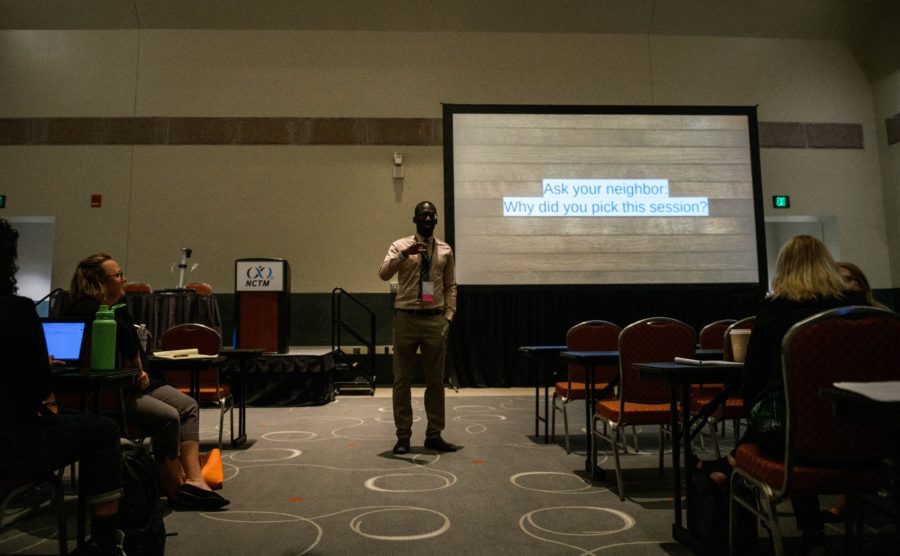I’ve been super busy at school and at home so I haven’t had time to reflect on my time at NCTM Boston. I had a morning talk doing teaching for social justice in algebra. I have a similar talk to one I gave a year ago and am preparing to shelve. The talk was great, and we created a Google doc full of ideas.
During a turn-and-talk, I started a conversation with someone sitting alone. They asked me about the Voyage of the Creole project, and how it qualifies as social justice and for a moment I was perplexed. It explores a historical event that illustrates and hopefully humanizes the people who were enslaved in the mid 1800s. The story can be inspiring or contextual for today’s society, but it isn’t about creating the immediate change today that I imagine this person was asking about. After a brief pause I said “the goal of whatever project isn’t to reach a certain objective of social justice, it’s about making students who are reflective and confident of how math can be a tool to examine complicated systems in our actual world and used to help make change.”
Defining a social justice project, and the larger goal of creating mathematically critical students was new for me. It wasn’t in my prepared notes or slides and the words formed as I talked. The distinction still holds true for me a month later, though. The goal isn’t for me to teach students about current events, but to help them to see and shape the world mathematically. The slavery project looked to me like an opportunity to connect math to student’s culture and identity. It was created at my old school whose students were largely black or afro-latinx. The social studies teacher on my team created a powerful unit on the middle passage and he suggested I connect to it in my math class. I found a story where kids were acting as a person that was enslaved, and needed to use math creatively to find freedom. Working on this project hopefully taught students a little history, and connected math to part of their identity for students whose ancestors may have been affected by the global slave trade.
Is that social justice or not? Perhaps. Trying to help students connect math to their culture and identity is an act of social justice, or perhaps a similar project around modern day slavery would be better at that process because we could immediately advocate for change in our actual world? If those two projects were sort of sitting on my desk and I had am choosing one to walk over the copy machine, I think the determining factor would be whether I could reach the goal that I rambled about earlier. Will it be really likely to help students feel confident using math to make change? In 20 years I want the students to confidently use math to face the myriad problems that this world will mired in. If those kids are in the middle of unit in history class that has them really engaged, and I have a chance to tag on and make a deep impact on how they see themselves, I’ll go with that project. If the kids would be more engaged in having a present-day context, it would be a no-brainer to use the latter project. At the end of the day, the teacher has the possibility to help students rethink what math is about through their contexts, how you can you make choices that can most impact the way students see math, and see themselves as mathematicians?
That exchange gave me a lot to think about, so thank you person-whose-name-I-forgot, and I guess thanks to the person who had been sitting next to you but left to go to another session. The talk is probably going to evolve into something else pretty soon, hopefully that will be more valuable. Stay tuned here
Right after that talk, I met up with my Co-Speaker Bushra Makiya for the second talk which went so much better than the disaster that it might have been. My laptop computer wasn’t projecting audio, and this was a talk with videos of student thinking, so we needed the audio. The technician came and couldn’t help, then what seemed like his supervisor came as well with no luck. The NCTM program committee member Kaneka Turner saved the day, letting us use her computer and hot spot. By the time we started using her computer, we were already 5 minutes into the talk. Because the room had bad service, we didn’t know the videos were going to be playable until just a few minutes before the videos were needed. We were crossing our fingers and hoping it would work the whole way. Thankfully, it did work out. Maybe next time we could bring a transcript and have participants act out student thinking.
Shortly after this my daughter had an ear infection so I had to cut my time in Boston short, but it was quite eventful. Also during my session the NCTM photographer guy stopped by and gave me a link to the pictures. They are worth checking out: https://www.schaeferpix.com/f1064671310


Leave a Reply